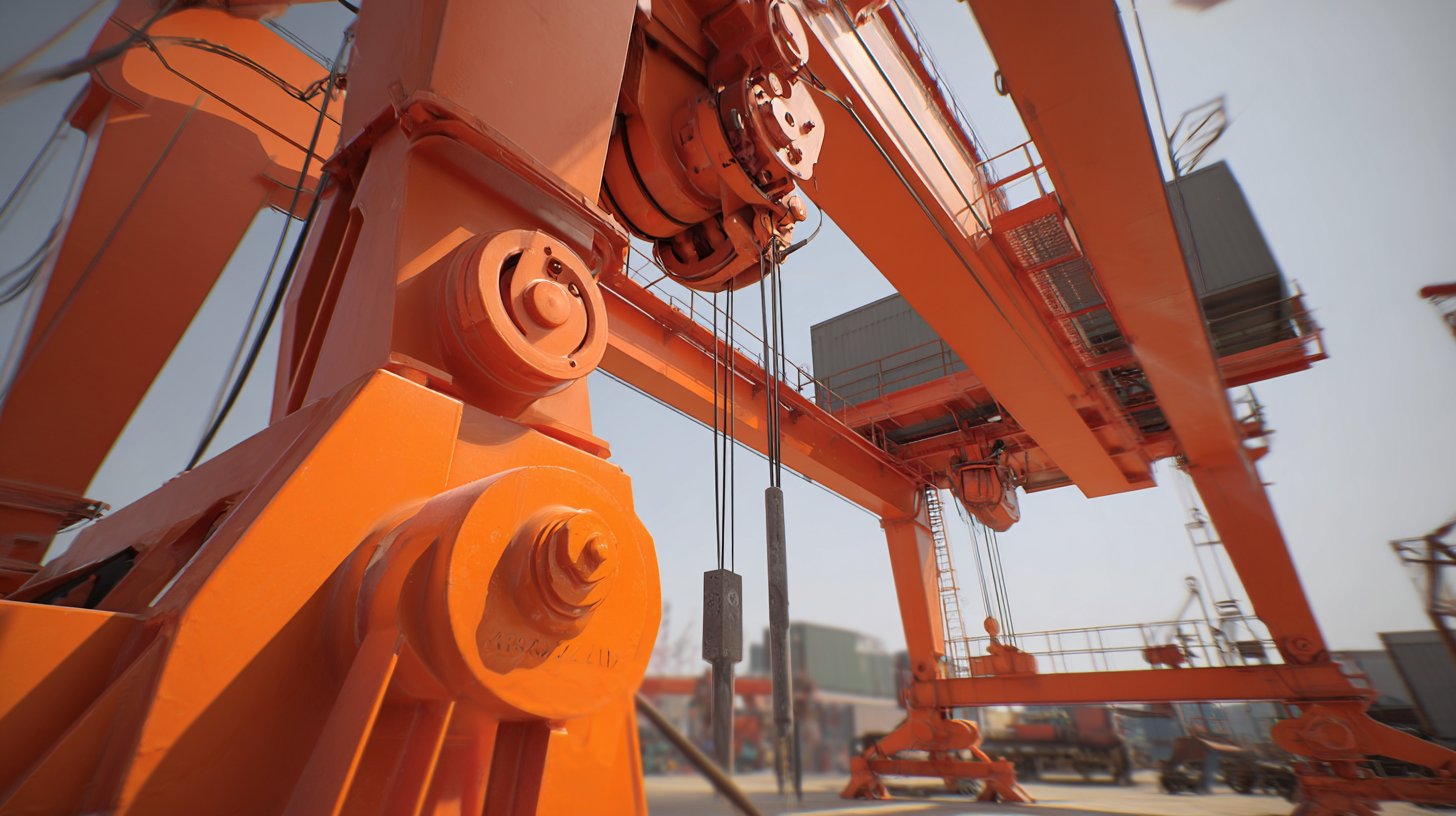Exploring Real World Applications of the Best Portable Jib Crane in Diverse Industries
In recent years, the demand for innovative lifting solutions has surged across various industries, with the portable jib crane emerging as a frontrunner in this evolution. According to a report by IBISWorld, the crane and hoist manufacturing industry is projected to grow at an annual rate of 3.5% from 2021 to 2026, driven by the increasing need for efficient material handling systems. The portable jib crane, recognized for its versatility and adaptability, has found applications in sectors ranging from construction to manufacturing. Its compact design allows for easy maneuverability and setup in tight spaces, making it an invaluable asset in modern operations. As we explore the real-world applications of the best portable jib cranes, we will uncover how these cranes are revolutionizing workflows and contributing to the technology development trends predicted for 2025.

Real World Applications of Portable Jib Cranes in Manufacturing Facilities
In the bustling environment of manufacturing facilities, portable jib cranes play a crucial role in enhancing productivity and efficiency. These versatile lifting tools can easily handle heavy loads, allowing workers to move materials with minimal effort. From assembly lines to warehouses, portable jib cranes streamline processes by reducing the physical strain on employees and speeding up operations. Their ability to be repositioned as needed makes them an essential asset in dynamic manufacturing settings where space is often at a premium.
When integrating portable jib cranes into your manufacturing facility, consider these tips: First, assess the weight and size of the items you will be lifting to choose the appropriate crane capacity. Additionally, ensure that the installation location has sufficient clearance and stability to accommodate the crane's operation. Regular maintenance checks are vital to keep the crane in optimal condition and ensure worker safety.
Another benefit is the adaptability of portable jib cranes in various tasks, from lifting raw materials to relocating finished products. Workers can benefit from proper training on the equipment, which can greatly reduce the risk of accidents. By investing in the right type of portable jib crane and training your staff, manufacturing facilities can significantly improve their workflow and overall efficiency.
Enhancing Warehouse Efficiency with Portable Jib Cranes in Logistics
Portable jib cranes are revolutionizing warehouse operations, particularly in the logistics sector. With the jib crane market expected to grow from USD 1.99 billion in 2025 to USD 2.64 billion by 2034, the demand for efficient material handling solutions is on the rise. These cranes offer the flexibility to lift and move heavy loads precisely where they are needed, enhancing productivity and minimizing manual labor.
 In logistics facilities, portable jib cranes streamline processes by allowing quick repositioning and setup in varying locations. This adaptability not only saves time but also reduces the risk of workplace injuries associated with manual lifting. As companies look to optimize their operations, investing in portable jib cranes becomes a strategic move that aligns with the industry's increasing emphasis on automation and operational efficiency.
In logistics facilities, portable jib cranes streamline processes by allowing quick repositioning and setup in varying locations. This adaptability not only saves time but also reduces the risk of workplace injuries associated with manual lifting. As companies look to optimize their operations, investing in portable jib cranes becomes a strategic move that aligns with the industry's increasing emphasis on automation and operational efficiency.
Tips: When selecting a portable jib crane for your warehouse, consider the load capacity and arm reach to ensure it meets your specific needs. Regular maintenance is crucial to prolong the life of the equipment, and training staff on proper usage can further mitigate safety risks. Investing in quality equipment and training ultimately leads to a more efficient warehouse operation, capable of meeting the growing demands of modern logistics.
Cost-Benefit Analysis: Why Industries Prefer Portable Jib Cranes for Heavy Lifting
In today's fast-paced industrial landscape, the need for efficient material handling solutions has never been greater. Portable jib cranes have emerged as a popular choice across various sectors, delivering flexibility and enhanced productivity. Conducting a cost-benefit analysis reveals that these cranes not only streamline operations but also provide significant financial advantages. With their easy setup and relocation capabilities, businesses can minimize downtime and optimize workflow, resulting in increased operational efficiency.
Furthermore, the investment in portable jib cranes often pays off quickly. Their versatility allows for heavy lifting in tight spaces, making them ideal for construction sites, warehouses, and manufacturing environments. Compared to traditional fixed cranes, portable models typically involve lower initial costs and reduced maintenance expenses. This affordability, combined with their robust performance, makes portable jib cranes an attractive option for industries looking to improve their lifting solutions without breaking the bank. Overall, the practical advantages and financial savings underscore why more industries are turning to portable jib cranes for their heavy lifting needs.
Exploring Real World Applications of the Best Portable Jib Crane in Diverse Industries - Cost-Benefit Analysis: Why Industries Prefer Portable Jib Cranes for Heavy Lifting
| Industry | Typical Load Capacity (lbs) | Cost of Portable Jib Crane ($) | Maintenance Cost (Annual $) | Return on Investment (ROI) (%) | Reason for Preference |
|---|---|---|---|---|---|
| Construction | 2000 | 1500 | 100 | 25 | Versatility and Space-Saving |
| Manufacturing | 1500 | 1200 | 80 | 30 | Improved Workflow and Efficiency |
| Warehouse | 1000 | 1000 | 60 | 20 | Space Efficiency and Portability |
| Automotive | 2500 | 1800 | 90 | 35 | Increased Safety and Reduced Labor Costs |
| Food Processing | 800 | 950 | 50 | 15 | Hygienic Design and Easy Cleanup |
Safety Regulations and Innovations in Portable Jib Crane Design for Construction
 The construction industry has long relied on innovative machinery to enhance efficiency and safety on job sites, and the portable jib crane is no exception. With its ability to lift heavy materials in tight spaces, this equipment has become essential in modern construction. However, the rise in its usage comes with a pressing need for adherence to safety regulations. Recent innovations have focused on integrating advanced safety features such as overload protection systems, enhanced stability mechanisms, and user-friendly controls. These advancements not only protect workers but also ensure compliance with increasingly stringent occupational health and safety standards.
The construction industry has long relied on innovative machinery to enhance efficiency and safety on job sites, and the portable jib crane is no exception. With its ability to lift heavy materials in tight spaces, this equipment has become essential in modern construction. However, the rise in its usage comes with a pressing need for adherence to safety regulations. Recent innovations have focused on integrating advanced safety features such as overload protection systems, enhanced stability mechanisms, and user-friendly controls. These advancements not only protect workers but also ensure compliance with increasingly stringent occupational health and safety standards.
Furthermore, the design of portable jib cranes is evolving to meet the diverse needs of various industries. Modular designs allow for easy transport and setup, making them indispensable on construction sites where space is limited. Incorporating lightweight materials without compromising strength is another area of focus to enhance maneuverability while maintaining safety. Additionally, companies are exploring smart technology integration, allowing cranes to be monitored remotely for real-time performance and safety assessments. As these innovations continue to reshape portable jib crane design, the construction industry stands to reap the benefits of both improved safety and operational efficiency.
Portable Jib Cranes: The Unsung Heroes in Automotive Assembly Lines
In the fast-paced automotive industry, efficiency and precision are paramount. Portable jib cranes have emerged as unsung heroes in automotive assembly lines, facilitating the seamless movement of heavy parts and components. According to a report by the Association for Manufacturing Technology, approximately 60% of assembly line inefficiencies can be attributed to material handling delays. This is where portable jib cranes shine, providing flexible support to operators as they lift and position loads with minimal effort.
The adaptability of portable jib cranes significantly enhances productivity, especially in environments where space constraints exist. A study by the Material Handling Industry of America found that integrating portable lifting solutions can improve workflow by up to 30%. These cranes enable teams to work smarter, allowing them to easily maneuver heavy engines, chassis, and other components without the risk of strain or injury. As automotive manufacturers continue to adopt lean manufacturing principles, the role of portable jib cranes becomes even more critical, ensuring that assembly lines remain efficient and responsive to production needs.
